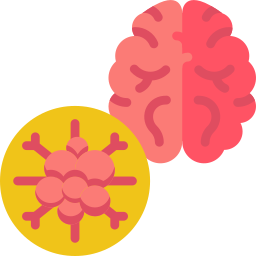![]() Brain Aneurysm
Brain Aneurysm
Cerebral aneurysms are lesions characterized by dilatations, most often saccular, in the wall of the arteries that supply the brain. They are more common in the age group between 35 and 60 years, being rare in children, although they can also occur in this age group. They are more common in women and, in most cases, develop throughout the life of individuals.
It is believed that brain aneurysms affect 1 to 6% of people, and these numbers may vary according to the population studied.
Most brain aneurysms do not cause symptoms, remaining silent until they rupture, causing a cerebral hemorrhage (subarachnoid hemorrhage), which most often presents as a sudden and severe headache, often described by patients as the worst headache of their lives.
Subarachnoid hemorrhage can have devastating effects, the clinical picture can range from a severe headache to more dramatic presentations such as limb paralysis, visual changes and even coma. Approximately 15% of patients die before receiving any kind of average care and about 4 out of 7 patients will develop some type of neurological dysfunction.
It is still a great challenge to identify, among patients who have asymptomatic brain aneurysms, the individuals who are more likely to develop an aneurysm rupture with consequent cerebral hemorrhage. It is known that this risk is associated with the presence of some factors, such as: location and size of the aneurysm, personal and family history of cerebral aneurysm rupture, presence of multiple cerebral aneurysms, arterial hypertension and smoking.
The treatment of cerebral aneurysms, before their rupture, when correctly indicated, can prevent all consequences of subarachnoid hemorrhage. On the other hand, ruptured aneurysms (those that have ruptured) must be treated urgently to prevent new hemorrhage, which can further worsen the initial condition, leading to a mortality rate of up to 80%.
There are two techniques for treating these injuries. Open surgery (microsurgery for clipping the cerebral aneurysm) and the endovascular approach (embolization of the cerebral aneurysm). The method chosen will depend on factors such as size, location, the patient’s clinical condition and the shape of the aneurysm.
Embolization, the preferred technique for the treatment of ruptured and unruptured cerebral aneurysms, consists of treating the aneurysm without opening the skull. It is a minimally invasive technique and also called the endovascular approach. The procedure is done by puncturing an artery in the body, usually the femoral artery, which is located in the groin area. With the use of X-ray and iodinated contrast, the endovascular neurosurgeon analyzes in real time and in detail, the entire cerebral circulation of the patient. Several types of materials can be used for occlusion of aneurysms, such as “springs” (detachable platinum coils), balloons and stents.
Microsurgery for brain aneurysm clipping consists of opening the skull and dissecting the arteries of the brain until exposing the aneurysm with subsequent clipping.
How to confirm the diagnosis?
Cerebral aneurysms are initially diagnosed in tests that evaluate the vascular structures of the brain, such as angioresonance or cranial computed tomography angiography.
Once the diagnosis is made with some of these tests, angiography/cerebral arteriography may be necessary for a detailed assessment of the characteristics of the aneurysm and programming the best treatment option.
What are the possible causes of brain aneurysm?
Smoking;
Arterial hypertension;
Family history of brain aneurysm;
Use of drugs
Polycystic kidney disease;
Some collagen diseases like Marfan Syndrome and Ehlers-Danlos.
What are the possible sequelae of brain aneurysm?
When a brain aneurysm ruptures, it leads to subarachnoid hemorrhage that can have devastating effects, with a mortality rate close to 40%. Approximately 15% of patients die before receiving any kind of average care and about 4 out of 7 patients will develop some type of neurological dysfunction.







